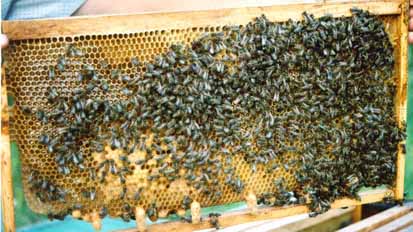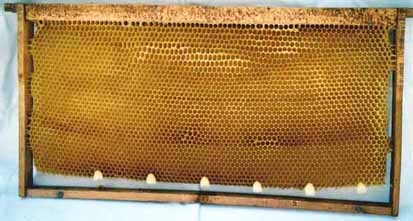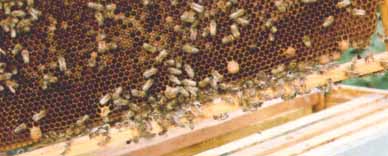Home
Srdjan Todorovski
Belgrade / Banatsko Plandiste
NEW PURPOSES OF ARTIFICIAL QUEEN CELL CUPS
(Biological role of bell shaped cells)
part 1
Queen cell cups are used in royal jelly production and queen rearing. They are most often made of wax or plastic materials. Queen cell cups are put on a frame bar, a larva is grafted, and such a frame is put into a cell building colony.
Larva grafting is a complex procedure which demands special conditions and equipment, and grafting does not guarantee a successful result; therefore, simplifying the process would enable much wider application of queen cell cups. This could be achieved if we could make bees move an egg into a queen cell cup themselves.
Before that, a problem should be solved – does a queen lay an egg into a queen cell cup or the bees move it in?
We start from generally accepted assumptions:
- During swarming bees make several queen cells, usually at the bottom of the frame and protect them from the old queen
- During supersedure bees make 2-4 queen cells in the middle of the frame
- In case of losing the queen, bees quickly draw a lot of queen cells anywhere on the comb on already fed larvae
There is no much word in books about the biological role of bell shaped cells. Some of their characteristics are observed in practice. They are neither studied nor applied in beekeeping enough. I hope this article is going to stress the importance of bell shaped cells for beekeeping practice.
We will make some assumptions:
- The “bell” cell has a strictly defined biological purpose, it serves as a base for swarming and supersedure queen cells
- According to what some beekeepers claim, during swarming and supersedure, nourishing bees move a chosen egg into the bell. This should be confirmed. (The presence of an egg can sometimes be seen in natural bells also.)
Supersedure queen cells are not considered in this article.
|
|
|
|
|
|
|
|
|
|
Image 2 |
Applying this knowledge a practical purpose can be found for queen cell cups:
- determining the readiness of a colony to swarm
- rearing queens
- preventing swarming
- royal jelly production
The main idea is to offer queen cell cups to bees on particular places on a marked frame, which bees will transform into bells.
The process begins in the same manner for all four purposes: An appropriate frame should be chosen. It can be:
Case 1: an empty light brown frame, evenly built, without natural bells
Case 2: a brood frame from the brood section with eggs, also without bells.
In both cases the frame should be marked in order to avoid the colony disturbance with consequent searching for it, which also takes a lot of time. Using melted wax we glue queen cell cups to the bottom part of the comb on both sides (image 1 and 8) or in the middle. Enough empty space should be left to avoid contact of the queen cells with the bottom board.
It is simple to do this at home with an empty frame at any time. Preparing the frame on the apiary, using brood frame speeds up the procedure, but demands additional equipment there.
In further text case 1 frame will be used. We use Langstroth hive frame or some other hive type where brood and super frames are of the same size. The queen excluder is put on the first, brood box. The race of bees is Carnica, local variety from Banat, enhanced with professor Kulincevic’s queens twice. The experiment was made on the territory of southern Banat (Vojvodina, Serbia and Montenegro).
The first experiences showed that the position of queen cell cups on the frame is important for the outcome of the experiment. That is why several side experiments were made.
Determining the position for placing the queen cell cups
|
|
 |
|
Image 3 |
|
|
|
Image 4 |
continue: part 2


